How to use an external hard drive with iPad Pro running iOS 13
Apple will eventually bring one of the most requested features to the iPhone and iPad later this year. External memory (last) support will come to both mobile devices with the release of iOS 13 and iPadOS 13, respectively. Especially on iPad Pro, this support can convince many people to abandon traditional computers, to switch to using tablet instead.
With external memory support, you can connect SD cards, USB drives and other mobile devices to your iPhone or iPad. To get started, all you have to do is connect the external device to your handset or tablet using the necessary cable. From there, you can read your documents through Apple's integrated Files application. You can then move or copy your files to other connected drives (if they are also attached to your mobile device via an external hub) or to your device's own hard drive. mobile.
This function works best with the latest generation iPad Pro models because they have USB-C and are Apple's most powerful and full-featured mobile devices to date. However, this functionality is also implemented in most cases with Lightning port devices, including iPhone and most iPads, using the Lightning-to-USB or Lightning-to-USB 3 camera adapter. Apple.
iPad Pro runs iOS 13 that supports storage on external hard drives
- Which drives are supported?
- Use external hard drive with mobile device
- Move files from external storage to mobile devices
- What about Safari on mobile?
- Some things to know more about the Files application
The article will focus on iPad Pro in the following examples.
Which drives are supported?
Apple has yet to confirm which type of hard drive will support external storage connections. However, support may include ExFAT, FAT32, HSF + and APFS. With this support, you can compress and decompress files without installing third-party applications on your device. You can also use the completely new Quick Actions like on a Mac. For example, you can rotate images stored on an external hard drive on a mobile device.
Use external hard drive with mobile device
Here are the steps to connect an external storage device to your mobile device:
1. Connect your external hard drive to iPhone or iPad using Lightning or USB-C port.
2. Click on Files application on mobile device. On the iPhone, you will need to click Browse in the application.
3. Select the hard drive name on the left side of the application.
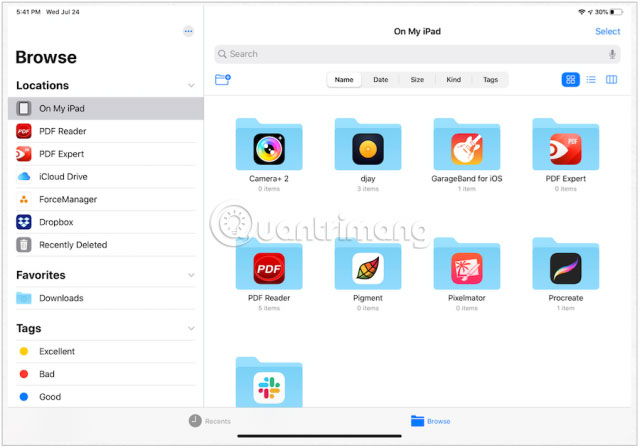
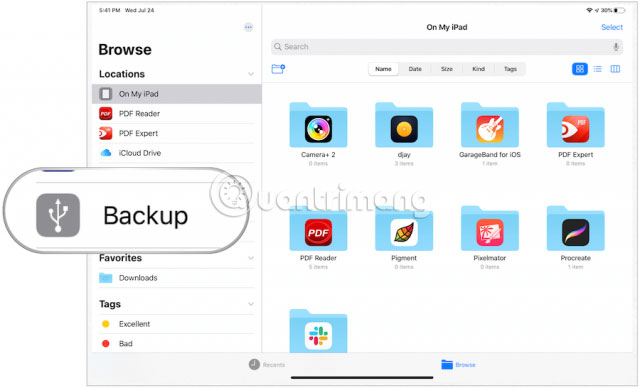
Move files from external storage to mobile devices
To move files from an external hard drive to an iPhone or iPad, do the following:
1. Click on the external storage device to the left of the Files app on your mobile device.
2. Select Select at the top right of the Files application.
3. Click the file (s) you want to move.
4. Select Move at the bottom of the application.
5. Click On My iPad .
6. Select Copy at the top right.
Files are now located on the hard drive of your mobile device.
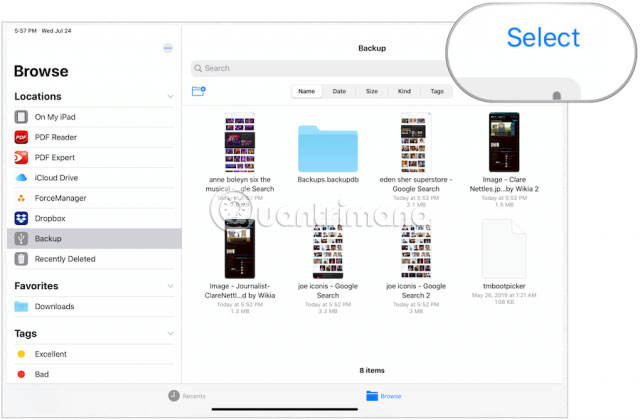
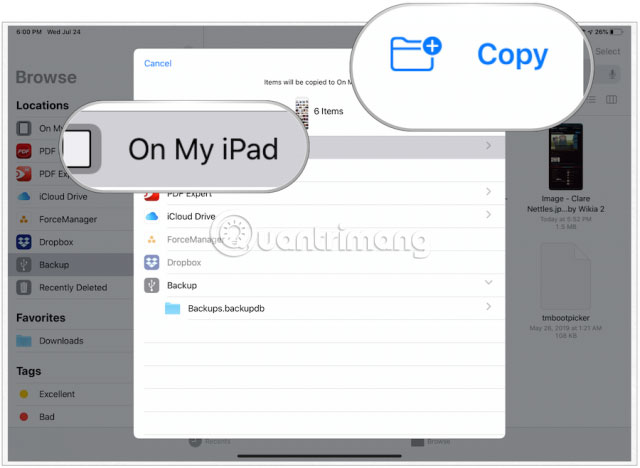
What about Safari on mobile?
One area where external storage support will bring immediate benefits is when using Safari on mobile. Instead of saving heavy web downloads like images to your iPad Pro hard drive, you can now save those files outside and save valuable space on your mobile device.
On iOS 13 or iPadOS 13 devices, do the following:
1. Touch the Settings app on iPhone or iPad.
2. Select Safari on the left of the application.
3. Click Downloads on the right.
4. Click Other . in Store Downloaded Files On .
5. Select your external hard drive.
6. Click Done.
From now on, downloaded files from Safari will automatically be sent to your external hard drive (when connected).

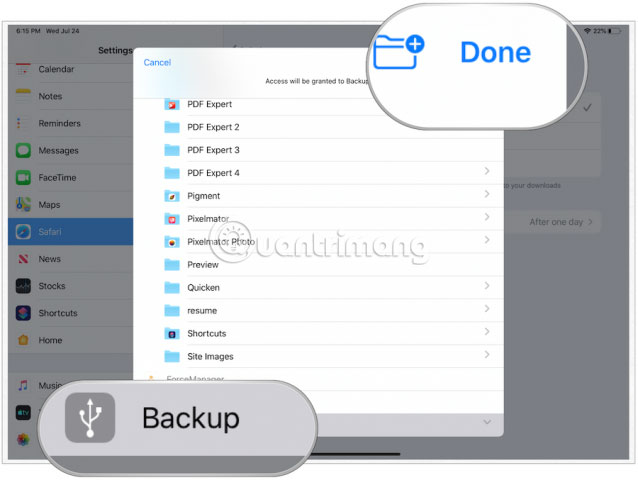
Some things to know more about the Files application
External memory support is not the only new feature that comes with the Fiiles application in iPadOS. Apple also introduced a multi-window tool. With this, you can open two Files windows side by side, allowing you to move folders and files more easily with drag and drop. In addition, there is a new column view mode, a great reminder of the Finder on Mac application.
Other new Files application features include:
- Local memory : Create folders on the local drive and add your favorite files.
- Rich metadata : Column view displays a rich set of metadata, so you can view details for each file when browsing.
- Share folders iCloud Drive : Share folders with friends, family and colleagues in iCloud Drive. You can even give them access to add their own files.
- File servers : Connect to file servers at work or home PCs with SMB from Files.
- Search by suggestion , help find what you want simpler. Just click on the proposal to quickly filter the results you need.
- Document scanner : Create digital copies of physical documents and place them directly in the location you want to store.
- Shortcuts : A variety of new shortcuts make navigating Files easier.
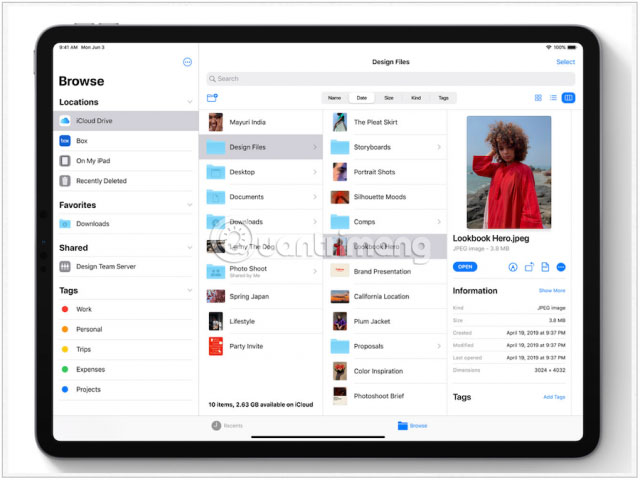
It's great to see Apple finally adding external storage support for iOS and iPadOS. Even with the advent of cloud computing technology, external hard drives still have a place in our daily lives. Apple finally realized this after many, many years. Potentially, iOS 13 and iPadOS will be officially released in September, along with new mobile devices in 2019.
You should read it
- How to fix an external hard drive error is not displayed on the Mac
- 7 simple ways to increase the life of your external hard drive
- Everything you need to know about external hard drives Xbox One
- Causes and ways to fix external hard drive slow on Windows 10
- How to reformat an external hard drive does not cause data loss
- Advice on buying an external hard drive
- How to use an external hard drive with a Chromebook
- How to Fix an 'External Hard Drive Not Detected' Error on PC or Mac
May be interested
- How to use an external hard drive with a Chromebook
 sometimes you may need to transfer files by moving the flash drive or have sensitive files that you don't want to store online. today's article will guide you how to use your flash drive or external hard drive with your chromebook.
sometimes you may need to transfer files by moving the flash drive or have sensitive files that you don't want to store online. today's article will guide you how to use your flash drive or external hard drive with your chromebook. - How to Fix an 'External Hard Drive Not Detected' Error on PC or Mac
 this wikihow teaches you how to fix an 'external hard drive not detected' error on your computer. there are a number of issues that can cause an external hard drive to not be detected. it could be a simple issue with the cord, usb port, or...
this wikihow teaches you how to fix an 'external hard drive not detected' error on your computer. there are a number of issues that can cause an external hard drive to not be detected. it could be a simple issue with the cord, usb port, or... - 5 best external hard drives of 2024
 external hard drives come in all shapes and sizes, from portable to more compact but permanent secondary storage devices. of course, the best external hard drive will be the one that suits your needs!
external hard drives come in all shapes and sizes, from portable to more compact but permanent secondary storage devices. of course, the best external hard drive will be the one that suits your needs! - How to turn an old hard drive into an external drive?
 it's easy to turn an old (or new) hard drive into a perfect external drive to store your secondary files.
it's easy to turn an old (or new) hard drive into a perfect external drive to store your secondary files. - Experience gold when choosing to buy an external hard drive
 external hard drive (hdd) has become an indispensable component for office users. however, many people still do not know how to buy them.
external hard drive (hdd) has become an indispensable component for office users. however, many people still do not know how to buy them. - How to Connect an External Hard Drive to a Macbook Pro
 usually, to connect an external hard drive to your computer, you just plug it in and that's it. however, with a macbook pro or any other mac, the hard drive must be formatted according to a file system supported by the mac. this process will erase all data on the hard drive. if like most hard drives on the market, your hard drive has been formatted with ntfs format, then with mac os x, you can only read but cannot write data on this hard drive.
usually, to connect an external hard drive to your computer, you just plug it in and that's it. however, with a macbook pro or any other mac, the hard drive must be formatted according to a file system supported by the mac. this process will erase all data on the hard drive. if like most hard drives on the market, your hard drive has been formatted with ntfs format, then with mac os x, you can only read but cannot write data on this hard drive. - How to Write to an External Hard Drive on Mac OS X
 writing to an external hard drive using max os x can sometimes be more complicated than one would assume. depending on how the drive is currently formatted, and whether or not you want to reformat it, you have a few possible options. if...
writing to an external hard drive using max os x can sometimes be more complicated than one would assume. depending on how the drive is currently formatted, and whether or not you want to reformat it, you have a few possible options. if... - What is a hard drive? There are several types?
 today most types of computers are large and small need to use hard drives, this is an extremely important part for computers, it has the ability to store all personal data and they are always accessed regularly. .
today most types of computers are large and small need to use hard drives, this is an extremely important part for computers, it has the ability to store all personal data and they are always accessed regularly. . - How to Back Up a Mac Without Time Machine
 this wikihow teaches you how to create a backup of your mac's hard drive contents without using time machine. buy an external hard drive. since you'll be using the external hard drive to back up your entire mac hard drive, the drive should...
this wikihow teaches you how to create a backup of your mac's hard drive contents without using time machine. buy an external hard drive. since you'll be using the external hard drive to back up your entire mac hard drive, the drive should... - How to Boot Your Computer from an External Hard Drive
 today's tipsmake will show you how to set up your computer to boot from an external drive instead of the built-in hard drive. this is useful when you need to run another operating system (such as linux) or install something that requires the internal hard drive to be offline.
today's tipsmake will show you how to set up your computer to boot from an external drive instead of the built-in hard drive. this is useful when you need to run another operating system (such as linux) or install something that requires the internal hard drive to be offline.










 How to change the directory to save the downloaded file from Safari on iPhone
How to change the directory to save the downloaded file from Safari on iPhone How to switch the gesture navigation feature of Android Q back to the old button system
How to switch the gesture navigation feature of Android Q back to the old button system How to speed up Wifi hotspots on Android phones
How to speed up Wifi hotspots on Android phones How to fix Android speakers does not work
How to fix Android speakers does not work How to automatically delete music on Apple Music when iPhone has low capacity
How to automatically delete music on Apple Music when iPhone has low capacity How to start with Android Debug Bridge
How to start with Android Debug Bridge